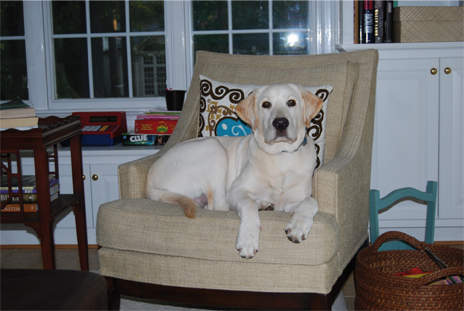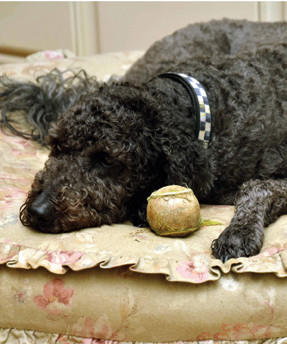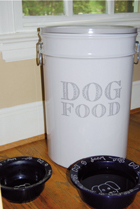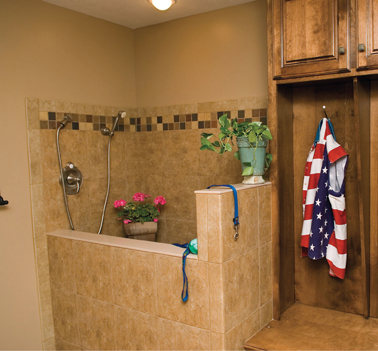No More Pet Peeves: Ideas for Fashionably Co-Existing with Furry Friends
 There he sat, all 80 pounds of him, folded with great effort in the seat of my new beige chair, paying no mind that he was not only dirtying up my new goods, but crushing the downy embroidered throw pillow that cost more than I’ll ever admit. “Percy!” I yelled. “Bad dog!” He stared back at me, nonplussed. So I did what any pet lover would do: I took a picture, his irreverence at once irresistible and infuriating, then shushed him down. It was the first of a handful of times, but eventually he got the message: no Percy on the new beige chairs. I’d love to take credit for rigorous training, but I can’t. We simply picked our battles, and our now-110-pound yellow lab, while a beloved part of our family, has gotten the message that some places in our home are off limits.
There he sat, all 80 pounds of him, folded with great effort in the seat of my new beige chair, paying no mind that he was not only dirtying up my new goods, but crushing the downy embroidered throw pillow that cost more than I’ll ever admit. “Percy!” I yelled. “Bad dog!” He stared back at me, nonplussed. So I did what any pet lover would do: I took a picture, his irreverence at once irresistible and infuriating, then shushed him down. It was the first of a handful of times, but eventually he got the message: no Percy on the new beige chairs. I’d love to take credit for rigorous training, but I can’t. We simply picked our battles, and our now-110-pound yellow lab, while a beloved part of our family, has gotten the message that some places in our home are off limits.
With careful training and consideration of all the pet products available to us, we can peacefully co-exist with our pets without sacrificing style in our homes. There is a multimillion-dollar industry that caters to our desire to live with these wonderful pets without letting our homes become overrun with the plastic gates and metal crates that seem to be necessary to keep them off the couch for good.
 Trained for Success
Trained for Success
Pet experts agree that establishing boundaries for your pet from the moment you bring him home is the most important thing you can do to keep the peace. Teach him where he is allowed and where he isn’t, and be consistent. Vets will tell you two great ways to do this: obedience classes and crate training. Crating a large dog, however, requires a crate the size of a small car. If this metal structure isn’t your idea of fashionable family room décor, you can buy a crate that is made to look like a piece of wooden furniture. Check out Orvis.com for a look at crates that look like endtables. You can also buy attractive crate covers in neutral fabrics or even fashionable prints (see callingalldogs.com for a few examples). Or if you want to block access to an entire room, consider investing in freestanding furniture-like baby gates. Made from wood, they adjust to fit just about any doorway, won’t scratch your floors, and aren’t as much of an eyesore as their rickety plastic counterparts.
 But what if you haven’t been diligent, and your pet is close to ruining your couch or bed? Can you, in fact, teach an old dog new tricks? You can absolutely try. With training, effort and persistence, you can teach your pet to respect the boundaries you put into place. Though training success is likely to be higher when your pet is younger, it’s never too late for pet classes. Also, consistency is key when it comes to teaching your pet boundaries. For example, allowing your pet on one couch or bed but not another is confusing, since reasoning isn’t your pet’s strongest suit. In other words, it’s not fair to Fido to allow him to lounge on the old couch but expect him to stay off of your new duvet. Keep their world, and your home’s boundaries, as black and white as possible; a yes or a no situation works best.
But what if you haven’t been diligent, and your pet is close to ruining your couch or bed? Can you, in fact, teach an old dog new tricks? You can absolutely try. With training, effort and persistence, you can teach your pet to respect the boundaries you put into place. Though training success is likely to be higher when your pet is younger, it’s never too late for pet classes. Also, consistency is key when it comes to teaching your pet boundaries. For example, allowing your pet on one couch or bed but not another is confusing, since reasoning isn’t your pet’s strongest suit. In other words, it’s not fair to Fido to allow him to lounge on the old couch but expect him to stay off of your new duvet. Keep their world, and your home’s boundaries, as black and white as possible; a yes or a no situation works best.
If you really can’t keep your pet off your furniture and don’t want to gate the whole room, you may want to consider a “scat mat”—a touch-sensitive training pad which tells your cat or dog “no” with a harmless static shock. Made of clear vinyl, the mat can be placed in the doorway to a room, across your sofa, or on your counters—any surface or area from which you want to keep your pet away. If your pet touches the scat mat, small pulses of electricity move through the wires embedded in the mat. These little zaps come as quite a surprise to your cat or dog, who will quickly learn to avoid the area, often even after the mats are removed. The zaps are not dangerous, and will not cause your pet any harm. Check it out at safepetproducts.com.
Another tool that can help keep your pets out of off-limit areas is a system that emits a strong puff of air, noise, or unpleasant scent when your pet approaches it. One such system—called the “SSCAT” system and available online at innotek.net—combines spray technology with a motion detector to protect indoor areas and objects from pets within a radius of about three feet. The device detects a pet’s movement as it approaches an off-limit zone, then releases a brisk, harmless spray. The pet is surprised and turns away.
 Add Style Through Accessories
Add Style Through Accessories
So now that you’ve done your best to establish limits and protect your prized furnishings, how about providing things that may even enhance your space? All the accoutrements for your dog’s daily constitutionals—the collar, leash, and waste disposal bags—tend to end up on the counter or near the door where you come and go. Take the time to create a place for these items so that they don’t add to the clutter in your home. Install a pretty hook and invest in a patterned leash that will make you happy every time you come and go. Coordinate the leash with a patterned collar and you will have not only a fashionable pet but possibly a great conversation starter. Folks in our area love to stop and chat when they notice Percy’s Hampden-Sydney College leash and collar and share stories of fellow alums.
Pet beds, too, have come a long way. Sure, an old bath mat or plain pet bed will do, but if you’re looking for style, you don’t have to look far. Pet beds come in almost as many patterns and varieties as our own couches and bedding—neutrals, stylish prints, slipcovers—that can even coordinate with your interiors. If you enter “fashionable dog beds” into your Internet search engine, you will be amazed at the options available (check out barkslope.com and poshpuppyboutique.com for starters). Four-poster, canopied and sleigh beds as well as a French-country settee…the options for fashionable bedding are endless. Just be sure to do your research; these beds can be pricey, and you need to consider that different breeds, sizes and fur-types have different sleeping requirements before you make a big purchase.
Even pet food storage presents you with an opportunity to make a style statement. There’s no need to stuff a gaping bag of food in your pantry or even to settle for a boring plastic storage bin. Invest in the attractive vintage-looking metal bins and scoops so popular right now, that won’t make you scowl each time you dig in. And pet bowls, which come in a variety of materials, can be placed on a pretty floor mat or even an iron or wooden stand that coordinates with your kitchen. There’s a style for every décor—rustic, modern, clean, eclectic. If you really want a custom look and fit, consider a “Designer Pet Eatery” (petsmart.com has an example)—a pet bowl system that is mounted within the wall and elevated to the desired height. It even contains a waterline, which allows you to run a line similar to that of a refrigerator hook-up, so that your pet always has fresh water. Due to the installation of the waterline through the home’s framing, though, the manufacturer recommends professional installation.
 A Truly Pampered Pet
A Truly Pampered Pet
One trend in new home construction is the inclusion of a “pet staging area” — a place to stash pet food, crates, litter boxes and even a special area to bathe and groom pets. Such staging zones are often included in a mudroom, laundry room, or even an unused corner of the garage. Other pet-friendly options to consider: a pet-sized window seat, built-in food and water bowls in your custom kitchen, or special pet doors so your pets can come inside and outside as they please. Cat lovers building a dream home may want to consider a “litter box cabinet” in the laundry or mudroom—a small cabinet tailor-made to house a litter box, complete with a small low-volume fan to keep things fresh.
Short of adopting a pet that matches your carpet (not that there’s anything wrong with that!), there are many ways to peacefully and fashionably co-exist with your pet inside your home. Don’t let the potential mess a pet can make discourage you from forging the life-giving relationship that pets can provide. After all, studies have shown that pet owners reap numerous physical and emotional benefits from spending time with their furry friends. From training and discipline to designer pet beds and food bowls, these practices and products help us share our homes with the beloved pets that have become part of our families.






